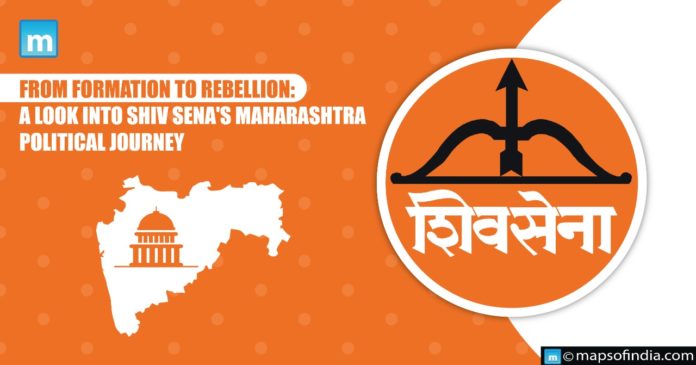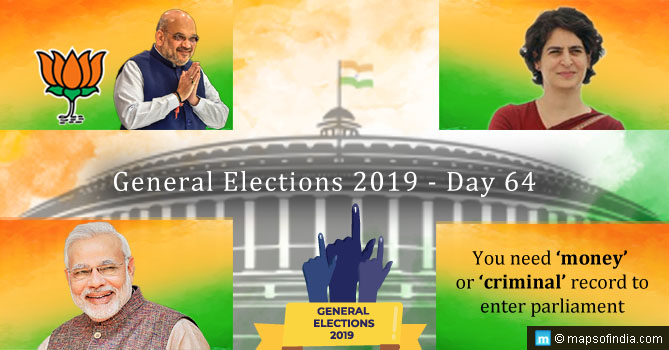The Indian state of Maharashtra has been in talks lately for different reasons than just Bollywood and increasing COVID-19 cases. This time it has been in the news for its political situation. The recent crisis in Shiv Sena has become a topic of interest among the nation. Everyone is keen to know what’s happening with state politics. A significant element of this whole political rift is the popular political party of Maharashtra named Shiv Sena.
Let’s have a look at the years-long history of Shiv Sena:
Balasaheb Thackeray, popularly known as Bal Thackeray, started a political weekly called ‘Marmik’ to raise awareness about the injustice in the state of Maharashtra through cartoons and sketches that got support from the masses. It all started when Maharashtra was established, and the migrators from other parts of the country began disrespecting the local culture.
To end this, he started a political party called Shiv Sena on June 19, 1966. The main objective of this political party was to fight against the injustice toward the Marathi people and to become a voice of Hindutva.
The party has three other wings. The student wing is called ‘Bhartiya Vidyarthi Sena (BVS). The youth wing is called ‘Yuva Sena’, and the women’s wing is called ‘Shiv Sena Mahila Aghadi’. It also produces a newspaper called ‘Saamana’. The party is headquartered in Shiv Sena Bhavan, Dadar, Mumbai.
The party is currently under the leadership of Uddhav Thackeray, and the youth wing of the party is under the supervision of his son Aaditya Thackeray.
Shiv Sena: A timeline from 1966 to 2015
1966: Shiv Sena was formed in June 1966, and his first grand ‘Melava’ was held in October 1966
1967: Its first rally for the rights of Marathi Man
1968: 42 out of 140 seats in Brihanmumbai Municipal Corporation (BMC) were won by Shiv Sena in March 1968. Then in August 1968, a grievance forum called Kamgar Sena was launched for Marathi Workers
1969: Shiv Sena prepared itself for the border dispute
1971 & 1973: A massive public meeting was held by Shiv Sena in 1971, and it announced the executive board for the party in 1973
1972 & 1973: Sthaniya Lokadhikar Samiti was established in 1972, and then Shiv Sena President announced the assembly election policy. In 1973, 39 corporators won from Shiv Sena, and Sudhir Joshi became the youngest Mayor
1974: Mahasangh of Sthaniya Lokadhikar Samiti announced
1978: Balasaheb gave Shivshakti and Bhimshakt slogans
1985 & 1986: Bombay became Mumbai in 1986 after Balasaheb’s declaration during the Mahad session in 1985
1989: In January 1989, ‘Saamna’, Shiv Sena’s newspaper, was launched, making the party voice reach every home. After completing Marathavada Daura, Balasaheb was given the ‘Hindu Hruday Samrat’. Also, the ‘bow and arrow’ became the party’s electoral symbol
1990 & 1991: Shiv Sena became a strong opposition after winning 52 seats in Maharashtra Assembly Polls. In 1991, the party completed 25 years
1955: Manohar Joshi became the Chief Minister of Maharashtra
1996: 15 Shiv Sena members elected as Member of Parliament in Delhi
1997: 103 corporators from Shiv Sena won in BMC
2002: Manohar Joshi became the Lok Sabha speaker
2003: Uddhav Thackeray became Party Working President
2005: Inauguration of renewed Shiv Sena Bhavan done by Bal Thackeray
2010: Yuva Sena was announced, and Aaditya Thackeray was declared its President. In May 2010, ‘Maharashtra’s Suvarna Mahotsav’ was celebrated on a large scale.
2014: 19 Member of Parliaments and 63 Members of Legislative Assembly were selected from Shiv Sena
2015: Shiv Sena completed 50 years
The Rebellion and its Aftermath
After the Legislative Council Elections of Maharashtra, Eknath Shinde (now Chief Minister of Maharashtra) was untraceable. Later, he was found in Surat along with 11 other MLAs of Shiv Sena.
When Uddhav Thackeray called a meeting, more MLAs were found missing. As a result, Shinde was removed from his position as Shiv Sena party Whip. Then Uddhav was asked by Shinde to break the Maha Vikas Aghadi (MVA) alliance and form a government with the Bhartiya Janta Party (BJP).
Shinde also claimed that he had support from 40 MLAs. Then on June 22, he, along with the 40 MLAs, flew to Guwahati in Assam. On the other hand, Thackeray announced that they would step down as the MVA alliance’s leader and the CM of Maharashtra.
This led to a series of accusations and major changes in Maharashtra politics. Then on June 29, 2022, Uddhav Thackeray resigned as the Chief Minister of Maharashtra. After several speculations regarding whether Devendra Fadnavis or Eknath Shinde would become the next CM, Shinde was sworn in as the new CM of Maharashtra on June 30.
Since Shinde started the rebellion, he claimed his majority of 39 MLAs out of the 55 MLAs of Shiv Sena. To prove this majority, a floor test was requested by Devendra Fadnavis on June 28.
Responding to the same, Maharashtra’s Governor Bhagat Singh Koshiyari sent a letter to then CM Thackeray stating the desire of 39 MLAs to exit the MVA government. It also stated that emails from 7 MLAs were received regarding Thackeray (then CM) losing the confidence of the majority. He then ordered a floor test to be held on June 30.
On July 4, 2022, Shide won the floor test after receiving 164 trust votes in a special session of the Maharashtra Assembly.





